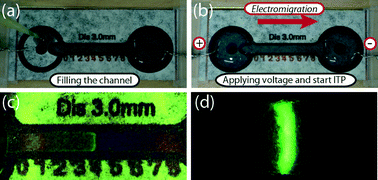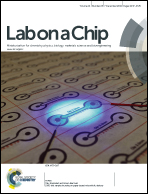1000-fold sample focusing on paper-based microfluidic devices†
Abstract
We present an experimental and analytical study of a novel paper-based analytical device (μPAD) for isotachophoretic sample focusing. Guided by a simple heat transfer model, we further developed wax printing fabrication to enable the creation of shallow channels, which are critical in providing sufficient dissipation of Joule heat, and thus enable the use of high electric fields and short analysis time. This results in a device that is self-contained on a simple piece of filter paper and does not require any specialized enclosures or cooling devices to combat evaporation at high temperatures. Furthermore, we provide an analytical model for isotachophoretic sample accumulation in porous media, introduce a simple figure of merit for evaluating and comparing the efficiency of such devices, and present experimental validation in both paper and glass channels. Using this device we demonstrate the processing of 30 μL of sample achieving 1000-fold increase in peak concentration in 6 min. We believe that this method and device can serve as a guide to the design of low-cost, rapid and highly sensitive paper-based diagnostic platforms.


 Please wait while we load your content...
Please wait while we load your content...